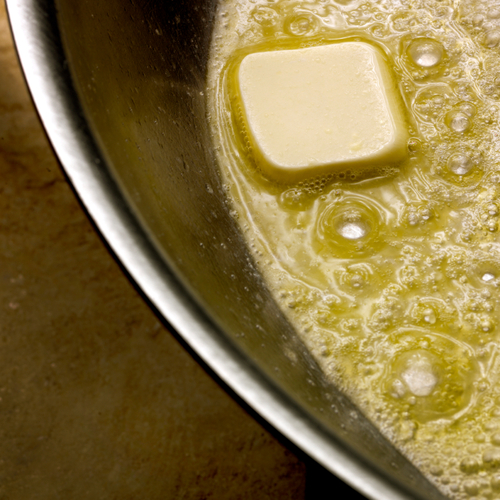
Featured Image: "Fine Cooking" by Brian Gieger
Adaptation: This recipe calls for browning butter in making Blondies. While this is a viable option another option and adaptation that can be made instead is to melt the butter. Melting butter instead of browning will change the science that is occurring in the recipe and therefore will change the final product of the Blondies. One change that will be seen if the butter is melted is the flavor which will become less toasted, Carmel-like, and nut-like. The Blondies will also become less soft in texture when the butter is melted because more water is used. This will happen because browning butter takes away a significant amount of water and results in less gluten development, as compared to melting butter.
Click here: For More Information on the Effects of Browning Butter.
Ingredients
Instructions
- 1. Pre-heat the oven to 350 degrees. Grease an 8 by 8-inch pan with butter. ___________________________________________________________________________________________________________________ Science Behind This: Greasing the pan makes it so that the batter from the Blondies does not stick onto the pan .
- 2. Place butter on a saucepan at medium heat until it is browned. Stir this occasionally. Cook until the butter foams and is a nutty brown color. Then pour into a large bowl. ___________________________________________________________________________________________________________________ Science Behind This: Heating the butter separates the butter into fat and milk solids. The milk solids brown and give the butter a toffee-like flavor. Browning the butter also takes out water and leads to a Maillard Browning reaction. Maillard Browning occurs due to reactions between a carbohydrate and an amino acid at temperatures above 250 degrees Fahrenheit. Maillard Browning is then responsible for the cooked color and flavor of the Blondies. (5)
- 3. In a separate bowl, whisk together flour, baking powder, and salt. ___________________________________________________________________________________________________________________ Science Behind This: Mixing the dry ingredients together separately helps to ensure that the leavening agents are dispersed evenly in the flour. This makes sure the batter is even. Flour is composed of 70% starch which helps to soak up the water that is in the batter. This soaking up of water helps give the Blondies their structure once baking is completed. Flour also contains proteins which also absorb water in the batter and make gluten. Baking powder serves as the leavening agent in this recipe and creates carbon dioxide which makes the batter spread upward during baking. Salt acts as a source of flavor in baking. It also releases aroma molecules in the air which gives off the smell. (1,2,3)
- 4. Add the brown sugar to the larger bowl with the butter and whisk until smooth. Add egg and vanilla and continue to whisk. Stir in the ingredients from the smaller bowl and pour all of this batter into the pan. ___________________________________________________________________________________________________________________ Science Behind This: The brown sugar and vanilla add flavor. Brown sugar is composed of sucrose crystals that are then covered in a syrup or molasses layer. It is more hydroscopic than other sugars which means one of its functions in the batter is to absorb water. The eggs and flour work together to add strength and reinforce the structure of the Blondie. Beating eggs adds and traps air to the egg which causes the batter to expand and makes the texture of the final product light and fluffy. Eggs are also composed of a significant amount of water which makes the product soft and richer. They also aid in increasing baked goods golden brown. (1,5)
- 5. Bake until a cake tester (or toothpick) comes out clean (20-30 minutes). Cool for 15 minutes before cutting. ___________________________________________________________________________________________________________________ Science Behind This: Heat and baking powder produced carbon dioxide bubbles which help make the blondies fluffy. It also gives the dough a light texture. (2). During the baking process, the gases are expanding and the leavening agents are leasing leading to the Blondie expanding once it is done cooking. The protein in the egg is also coagulating as the granules of starch are swelling and gelating. It is also during this stage that the batter solidifies and the flavor becomes enhanced.
Notes
Science of Recipes: Sources
Recipe and Instructions from Serious Eats
- Read More about Flour
- Read More about Baking Powder
- Read More about Salt
- Read More about Eggs
- Read More about Butter
All citations can be found on the Recipe At A Glance Page